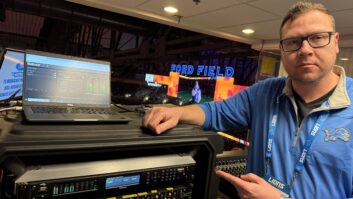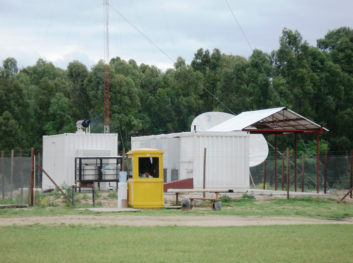
In the May 9 issue of Radio World, I reported on a recent power upgrade at TWR’s Bonaire AM facility that brought that station close to the half-megawatt level (440 kW), allowing the station to make the claim that it is the most powerful medium-wave (MW) operation in the Western Hemisphere. After the dust settled, I thought it might be interesting to poke around a bit in the data available to see if they have a close (or even not-so-close) contender for second place for this title.
HISTORICAL BACKGROUND
With only a few exceptions, U.S. stations have been capped at 50 kW since this power level was authorized by the Federal Radio Commission in the late 1920s. Powel Crosley Jr.’s WLW 500,000 kW 1930s “experimental” operation is one very well-known example, as it received a lot of publicity during the five years or so during it operated before being powered down. However, there was another much less well-known superpower operation during that period (it actually beat WLW to the punch by putting 400,000 Watts on the air about three years before Crosley was ready to belt out his hundreds of kilowatts).
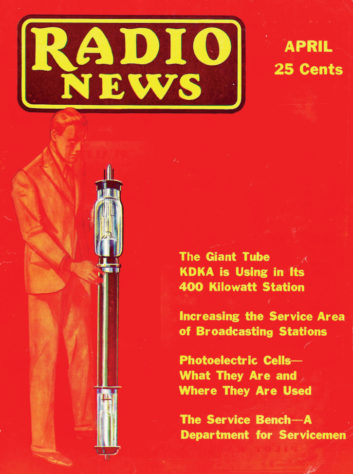
I’m referring the Pittsburgh’s KDKA, which made the cover story of the April 1931 Radio News magazine. The article itself was titled: “KDKA: Radio’s New 500 Horsepower Voice.” (Why the writer took the “horsepower” approach to power isn’t really known. Perhaps 500 horses might seem slightly more impressive than 400 kilowatts. But if you do the math, one horsepower is equivalent to about 745 watts, so 500 hp would amount to some 373 kW instead of the 400 the article claimed.)
Also, it’s not clear why the station took on the construction of a 400 kW rig without some assurance they could operate at that level. Perhaps it was a “proof of concept” that turned out to be not that successful, or possibly the economic realities of the Great Depression killed the project before it got past the experimental stage.
Here’s an excerpt from that account:
“KDKA Builds for Tomorrow” — Anticipating the continuing and increasing rapid growth of broadcast service, KDKA has recently built a new 400,000-watt transmitter at Saxonburg, Pa. The new station has been operating experimentally between 1 a.m. and 6 a.m. For normal operations, however, the power will be held at 50,000 watts as required by the Federal Radio Commission.
Actually, the Radio News article seemed to place more emphasis on the specially designed 200 kW tube engineered by Westinghouse to power the new transmitter:
One of the most important innovations is the new tube with a capacity of 200 kilowatts. This tube is not merely an enlarged edition of a smaller tube, but is thoroughly engineered as a tube of larger size and of a distinctly novel design.
This tube was known as the AW-220, and was not “vaporware,” as it remained in the tube industry’s registry for some time. It weighted in at 60 pounds, was 72-inches tall and had an eight-inch diameter. According to the article, two were used in the KDKA “big rig.”
While WLW’s superpower operation turned out to be more of a reality than KDKA’s, a stroke of the pen in 1939 relegated the Mason, Ohio big rig to collecting dust and taking up floor space.
THROWING BIG FLAMES IN THE 21ST CENTURY
That was then. This is now. So who’s got the >50 kW action now (aside from TWR’s Bonaire facility)?
Surprisingly, there is one U.S. AM station that has the necessary paperwork and equipment to operate at 100 kW full-time. However, it’s not listed in the FCC’s AM database. I’m referring to the VOA’s “Radio Martí” in Marathon, Fla. which operates on 1080 kHz.
[Read More Interesting Articles by James O’Neal]
The VOA station (it sports no call sign) appears to be the only operation in its class in the U.S. and Canada, but it if you cross the border into Mexico, you’ll find “muchas estaciones de radio” that emit lots more than a puny 50,000 “vatios.”
BIG RIGS SOUTH OF THE BORDER
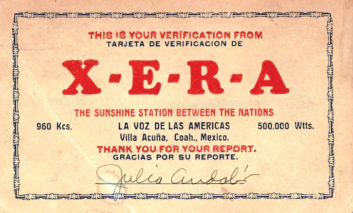
Some of these stations are obviously the remnants of the deep-voiced 1930s “border blasters.” (I refer especially to the present-day station bearing a slight variation of the notorious Dr. Brinkley’s original Mexican call sign, XER, now XERF.) Just as established by Brinkley, XERF is still located right across the Rio Grande from Del Rio, Texas in Ciudad Acuña. According to the FCC’s database, it’s licensed to operate at 250,000 Watts. During the 1930s, Brinkley’s XER/XERA was described in radio publications at various times as operating at 75, 250, 300 and 500 kW.)
There’s another Mexican border blaster with which this author is well acquainted. This is XEG, operating on 1050 kHz and with a full-time power of 150 kW according to current FCC information. During the 1950s and ’60s when I was doing my growing up in southwest Arkansas, I suspect it may have operated with more power than this. I recall on many occasions as I tried to listen to the latest top 40 hits from New Orleans’ 1060 kHz WNOE (now WLNO) operating with a nighttime power of 5 kW, XEG’s powerful sidebands totally obliterating WNOE.
Looking at other high powers in Mexico, the FCC shows another with parity to XERF’s 250 kW — Mexico City’s XEW operating on 900 kHz.
SOME CONTRADICTORY INFORMATION
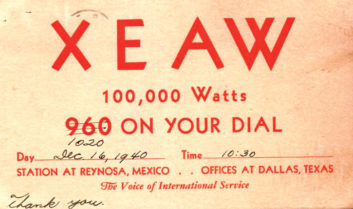
Digging further into high-power stations south of the border, things get a bit interesting and potentially dicey. Before proceeding further, a description off my research is in order.
I first went to the FCC’s database and did a pull of AM stations, and then picked out the >50 kW stations from the thousands listed. This was a bit of a challenge as the database is not set up for this sort of data mining, so I could have missed a few. My second source of information was the 2018 edition of The World Radio TV Handbook or “WRTH,” again, a source not lending itself to quick searches of “ultra flamethrowers.” In comparing the data retrieved, I did spot variances (in several cases extreme) between the FCC and the WRTH. As an example, the WRTH shows XERF at 100 kW instead of the FCC’s 250 kW figure.
A possible explanation is that commission’s info is either out of date, or wattage numbers shown are for “licensed,” as opposed to “actual” power. Not having the resources to investigate each superpower one-by-one, I’m assuming it’s the latter, with the WRTH info being indicative of the real number of watts exiting the various transmitter output ports. However, if anyone has better information, please come forward, as the power levels for a couple of stations could dethrone Bonaire’s claim to highest power in this hemisphere. In the listings that follow, where there is a difference, I’m showing the FCC number followed by the WRTH figure in parenthesis. Here’s a rundown of other Mexican superpowers located:
- XEROK – Ciudad Juárez – 800 kHz – 150 kW D/N (50 kW)
- XEWA – (San Luis Potosi – 540 kHz – 150 kW D/N
- XEQ – Mexico City – 940 kHz – 150/50 kW (50 kW)
- XEX – Mexico City – 730 kHz – 100 kW D/N
- XEB – Mexico City – 1220 kHz – 100 kW D/N
- XETQ – Orizaba – 850 kHz – 100/50 kW (absent in WRTH)
- XEEP – Mexico City – 1060 kHz – 100/20 kW kW
- XETRA – Tijuana – 690 kHz – 77/50 kW (absent in WRTH; likely now XEWW below)
- XEWW – Rosarito Beach – 690 kHz – 77/50 kW (78/50 kW)
GOING BEYOND MEXICO
Cuba has a number of AM “superstations,” at least on the FCC’s ledger. (Most, if not all, appear to have been created during the cold war and were used for either propaganda purposes or possibly interfering with U.S. stations.)
Here’s the FCC’s Cuban list:
- CMBV – Wajay – 550 kHz – 500 kW
- CMCA – San Antonio de las Vegas – 590 kHz – 150 kW
- CMKA – San Germán – 600 kHz – 150 kW
- CMKB – Cacocum – 900 kHz – 200/50 kW
- CMBX – Wajay – 1010 kHz – 500 kW
However, the WRTH doesn’t support any of this information, showing only three “superpowers:
- CMBA – Chambas – 710 kHz – 200 kW)
- CMBC – Chambas – 890 kHz – 200 kW
- CMBA – Martí – 1180 kHz – 200 kW
(According to WRTH data, the CMBA call sign is duplicated numerous times.)
Venezuela lays claim to several superpowers. Here’s the rundown for that country:
- YVKE – Caracas – 550 kHz – 100 kW D/N (50 kW)
- YVLX – Villa de Cura – 570 kHz – 100/50 kW (100 kW D/N)
- YVLL – Caracas – 670 kHz – 100/50 kW (100 kW D/N)
- YVKY – Caracas – 710 kHz – 100/50 kW (50/20)
- YVQE – Palomar – 720 kHz – 100 kW (absent in WRTH)
- YVKS – Caracas – 750 kHz – 100/50 kW (100 kW D/N)
- YVTB – Maracaibo – 800 kHz – 100/50 kW (absent in WRTH)
- YVKG – Caracas – 950 kHz – 100/50 kW (absent in WRTH)
Chile also boasts a couple of big ones:
- CB-106 – Santiago – 1060 kHz – 100 kW
- CB-114 – Santiago – 1140 kHz – 100 kW
Colombia is supposedly home to some superpowers, but the FCC and WRTH again are at odds:
- HJND – Bogotá – 570 kHz – 100 kW
- HJCR – Medellin – 590 kHz – 100/50 kW (50 kW)
- HJBU – Zambrano – 680 kHz – 100/50 kW (not in WRTH)
- HJCX – Cali – 700 kHz – 120/50 kW (30 kW)
- HJBW – Bucaramanga – 800 kHz – 100 kW (FCC records say 10 kW)
- HJCY – Bogotá – 810 kHz – 250 kW (60 kW)
- HJHN – Magangué – 960 kHz – 120/50 kW (10 kW)
- HJES – Cali – 980 kHz – 100 kW (FCC says 10 kW)
- HJDB – Medellín – 990 kHz – 150/50 kW (WTRH says 50 kW and gives call as HJCH)
Ecuador is a real “puzzler,” with the FCC showing nine >50 kW operations, but the WRTH showing no stations in that country with more than 50 kW and omits a couple of the FCC-listed stations altogether. For the record, here’s what the FCC shows:
- HCMJ1 – Quito – 610 kHz – 100/50 kW
- HCXY1 – Quito – 640 kHz – 100/50 kW
- HCJB1 – Quito – 690 kHz – 100/25 kW
- HCQR1 – Quito – 760 kHz – 100/25 kW
- HCPN1 – Quito – 1600 kHz – 100 kW
- HCLG2 – Guayaquil – 660 kHz – 100/10 kW
- HCRS2 – Guayaquil – 710 kHz – 100/50 kW
- HCDE2 – Guayaquil – 940 kHz – 100/50 kW
- HCAH2 – Guayaquil – 960 kHz – 100/50 kW
Paraguay sports two stations in the greater-than-50 kW class:
- ZP-1 – Asunción – 920 kHz – 100 kW
- ZP-9 – Asunción – 970 kHz – 80 kW (FCC says only 5/1 kW)
Argentina also makes the FCC’s list with at least two “biggies”:
- LRA7 – Córdoba – 750 kHz – 100 kW
- LRA1 – Buenos Aires – 870 kHz – 100 kW
- LS11 – Buenos Aires – 1270 kHz – 100 kW (WRTH only; not shown in FCC records)
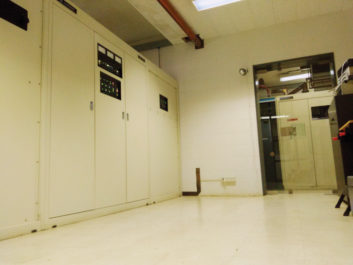
I was able to get some first-hand information about Argentina’s superstations from a friend living there, Valentin Trainotti. According to his information, there are more than a dozen >50 kW stations in that country, with five running at 200 kW: LR5 (910 kHz), LR6 (790 kHz), LRL202 (710 kHz), LS4 (590 kHz) and LV3 (700 kHz).
Even though the FCC database indicates five >50 kilowatters in Uruguay, the WRTH is again not in agreement:
- CX6 – Montevideo – 650 kHz – 200 kW (25 kW)
- CX12 – Montevideo – 770 kHz – 125 kW (100 kW)
- CX14 – Montevideo – 810 kHz – 100 kW (50/25 kW)
- CX16 – Montevideo – 850 kHz – 100 kW (50 kW)
- CX26 – Montevideo – 1050 kHz – 100 kW (50 kW)
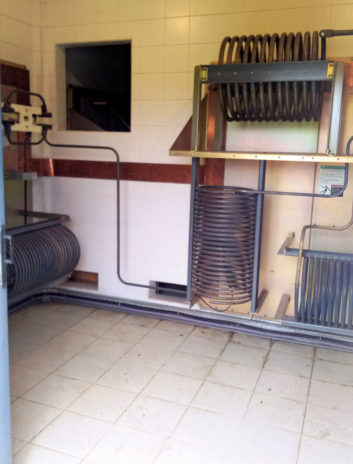
However, both of these information sources are disputed by my Uruguayan friend, Rafael Sotelo, who worked at the television facility owned by CX16. He says their big AM rig (at least between 1991 and 2010) was a 50 kW Continental.
Also, he’s not really aware of anyone running more than 50 kW in Uruguay today, concluding that “the business of the AM radio is not what it used to be.”
The island of Montserrat is another anomaly, with the FCC showing two very high-power operations (neither having a call sign):
- 740 kHz – 300 kW
- 930 kHz – 500 kW
But the WRTH shows no AM broadcasting there.
There’s another anomaly with St. Kitts/Nevis. According to the FCC, there are two >50 kW ops there:
- No call sign – Conaree – 820 kHz – 100 kW
- No call sign – Conaree – 1260 kHz – 100/50 kW
(The WRTH reports only a solitary AM — an 860 kHz station running 10 kW.)
LOTS AND LOTS OF AM WATTS DOWN IN BRAZIL
I’ve been saving Brazil for last for special reason. There’s an old song with the line “They’ve got an awful lot of coffee in Brazil.” And while that’s true, it seems Brazil also rules the roost for kilowatts of AM radio. There are many, many medium wavers down there running at all sorts of power levels. These superpowers stand out from the crowd:
- ZYK-275 – Porto Alegre – 600 kHz – 100 kW (the WRTH gives the call as ZYK-278)
- ZYK-276 – Porto Alegre – 720 KHz – 100 kW
- ZYI-770 – Recife – 720 kHz – 100 kW
- ZYA-446 – Salvador – 740 kHz – 100 kW
- ZYH-705 – Brasília – 800 kHz – 50 kW day/600 kW night (not a typo) (WRTH, however, says 10/1)
- ZYJ-457 – Rio de Janeiro – 800 kHz – 100 kW
- ZYK-687 – São Paulo – 840 kHz – 100/50 kW
- ZYJ-459 – Rio de Janeiro – 860 kHz – 100 kW
- ZYL-275 – Belo Horizonte – 880 kHz – 100 kW
- ZYJ-453 – Rio de Janeiro – 940 kHz – 100 kW
- ZYH-707 – Brasília – 980 kHz – 50/600 kW (not a typo either; but WRTH says 50/300 kW)
- ZYJ-460 – Rio de Janeiro – 990 kHz – 100/10 kW (WRTH call it ZYJ-461)
ZYK-522 – São Paulo – 1000 kHz – 200 kW - ZYJ-467 – Rio de Janeiro – 1030 kHz – 100/5 kW (FCC says it’s 50/5)
- ZYK-537 – São Paulo – 1040 kHz – 200/100 kW
- ZYK-694 – São Paulo – 1100 kHz – 150 kW (WRTH says it’s 50/50)
- ZYJ-461 – Rio de Janeiro – 1130 kHz – 100/50 kW (WRTH gives the call as ZYJ-460)
- ZYJ-458 – Rio de Janeiro – 1220 kHz – 150 kW
- ZYK-688 – São Paulo – 1260 kHz – 100/50 kW (100/40)
- ZYJ-455 – Rio de Janeiro – 1280 kHz – 100 kW
- ZYK-766 – São Paulo – 1370 kHz – 100/20 kW (not in FCC database)
So, there you have it — a compilation of all (I hope) of the really heavy-hitter AM players in this hemisphere. And with the possible exception of Brazil’s ZYH-705 and ZYH-707 (I’m going to go with the World Radio TV Handbook’s version of the facts), it looks as if the new 440 kW voice of Bonaire (call sign PJB) is still king of the kilowatts on this side of the planet!
James O’Neal is a longtime contributor to Radio World and former technology editor of our sister publication TV Technology. In October, he will be elevated by the Society of Motion Picture and Television Engineers to its membership grade of Fellow.
Comment on this or any story. Write to [email protected].





